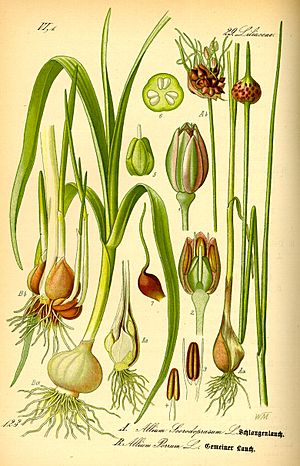Sand leek facts for kids
Quick facts for kids Sand leek, rocambole |
|
|---|---|
 |
|
| Allium scorodoprasum | |
| Conservation status | |
| Scientific classification | |
| Synonyms | |
|
Synonymy
Ascalonicum scorodoprasum (L.) P.Renault
Porrum scorodoprasum (L.) Rchb. Allium arenarium L. Allium contortum Stokes Allium obscurum M.Bieb. ex Schult. & Schult.f. Porrum arenarium (L.) Rchb. Allium neglectum Wender. Allium scorodoprasum var. multibulbillosum Y.N.Lee Allium supranisianum Sailer Allium persicum Fisch. ex Regel |
The sand leek (Allium scorodoprasum) is a type of wild onion. It is also called rocambole or Korean pickled-peel garlic. This plant grows naturally across a large part of Europe, the Middle East, and Korea. It's important not to mix it up with rocambole garlic. That one is a different plant, a type of Garlic.
Contents
What Does the Sand Leek Look Like?
The sand leek is a plant that lives for many years. It has a bulb shaped like an egg under the ground. The plant grows two to five leaves that do not have stalks. The bottom parts of these leaves are like sheaths.
Each leaf is long and thin, about 7 to 20 millimeters wide. They are flat with a small ridge in the middle. The edges of the leaves and the main vein feel rough. The whole plant smells like an onion.
The main stem that holds the flowers is round. It grows to be about 30 to 90 centimeters tall. The top half of this stem has no leaves.
Flowers and How They Grow
The sand leek's flowers grow in a round cluster. This cluster is covered by thin, papery leaves when it's a bud. These leaves dry up when the flowers open. Each flower has its own small stalk.
The flowers have purple petals, about 4 to 7 millimeters long. There are six petals and six stamens. Stamens are the parts that make pollen. There is also a pistil, which is the part that makes seeds.
Mixed in with the flowers are many small purple bulbils. These are like tiny bulbs. The plant does make a fruit capsule, but it rarely produces seeds. Instead, new plants usually grow when these bulbils fall off.
Where Does the Sand Leek Grow?
The sand leek naturally grows in damp forests with wide-leaved trees. You can also find it at the edges of forests, near shores, in meadows on hillsides, and along hedgerows.
Long ago, people used sand leek as a cooking herb. Because of this, you can sometimes find it growing near old homes or settlements.
Growing and Using Sand Leek
The sand leek is a plant you can eat. However, people do not grow it very often. It has a shorter flower stalk compared to Rocambole garlic. Its cloves are also fewer and not as evenly shaped.
The sand leek also has a dark purple wrapper around its bulb. Sometimes, a plant called Elephant garlic is mistakenly sold as sand leek. Elephant garlic is actually a different plant.
See also
 In Spanish: Allium scorodoprasum para niños
In Spanish: Allium scorodoprasum para niños


